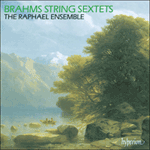
Welcome to Hyperion Records, a British classical label devoted to presenting high-quality recordings of music of all styles and from all periods from the twelfth century to the twenty-first.
Hyperion offers both CDs, and downloads in a number of formats. The site is also available in several languages.
Please use the dropdown buttons to set your preferred options, or use the checkbox to accept the defaults.

The succeeding G minor Scherzo wavers between melancholy and gentle playfulness with a well-contrasted middle section, ‘Presto giocoso’, incorporating a thumping Ländler rhythm. The Adagio is in E minor and once more finds Brahms using his beloved variation technique to great effect. A slow, sad melody, supported by distinctive chromatic harmonies, is followed by a succession of varied renditions of the thematic material whose melodic connections are less obvious than are the rhythmic and cadential ones.
The last movement sustains Brahms’s sunny mood and the music has an unhurried gait, despite the fugal writing in the development section. The main theme is first marked ‘Tranquillo’ and, later, ‘Semplice’, and it moves effortlessly in triple time. The return of the fugue ensures a rousing conclusion to one of Brahms’s most happy inspirations.
from notes by Peter Lamb © 2000
Le Scherzo en sol mineur suivant oscille entre mélancolie et douce espièglerie, avec une section centrale bien contrastée, «Presto giocoso», incorporant un formidable rythme de ländler. L’Adagio en mi mineur voit, une fois encore, Brahms recourir à ses chères variations, avec force efficacité. Une mélodie lente, triste, soutenue par de distinctives harmonies chromatiques, précède une série de traductions variées du matériau thématique, dont les liens mélodiques sont moins évidents que les liens rythmiques et cadentiels.
Le dernier mouvement prolonge l’humeur ensoleillée de Brahms et la musique a une allure tranquille, malgré l’écriture fuguée de la section de développement. Le thème principal, d’abord marqué «Tranquillo» puis «Semplice», se meut sans efforts dans une mesure ternaire. Le retour de la fugue assure une vibrante conclusion à l’une des plus heureuses inspirations de Brahms.
extrait des notes rédigées par Peter Lamb © 2000
Français: Hypérion
Das nachfolgende Scherzo in g-Moll schwankt zwischen Melancholie und sanfter Verspieltheit, mit einem sauber abgesetzten Mittelteil „Presto giocoso“, in dem ein wuchtiger Ländlerrhythmus vorkommt. Das Adagio steht in e-Moll; Brahms weiß hier wiederum seine geliebte Variationsform höchst effektvoll einzusetzen. Auf eine langsame, traurige Melodie über charakteristisch chromatischen Harmonien folgt eine Serie abgewandelter Darbietungen des Themenmaterials, deren melodische Beziehungen zueinander weniger offensichtlich sind als die rhythmischen und kadenzialen.
Der letzte Satz erhält Brahms’ sonnige Stimmung aufrecht, und die Musik schreitet trotz der fugalen Satzweise in der Durchführung gemächlich voran. Das Hauptthema ist erst mit „Tranquillo“, später mit „Semplice“ bezeichnet und bewegt sich mühelos im Dreiertakt. Die Wiederkehr der Fuge gewährleistet einen erhebenden Abschluß zu einer von Brahms’ glücklichsten Schöpfungen.
aus dem Begleittext von Peter Lamb © 2000
Deutsch: Anne Steeb/Bernd Müller
 Brahms: String Sextets Brahms: String Sextets‘Glorious performances … [they] can take their place beside any of the great chamber music recordings of the past, and will continue to set stand ... ‘These are superb performances; the recording is vivid and immediate’ (The Penguin Guide to Compact Discs)» More |

